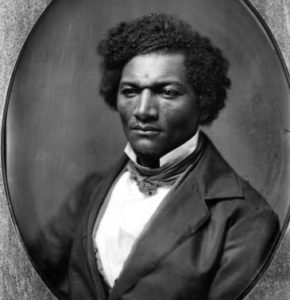 In early June of this year, Onondaga Historical Association (OHA) learned that it successfully obtained conservation funding from the Greater Hudson Heritage Network (GHHN) in Elmsford, NY to preserve its rare, whole plate daguerreotype photograph of Frederick Douglass, the famed 19th century African-American orator, abolitionist, social reformer, and statesman.
In early June of this year, Onondaga Historical Association (OHA) learned that it successfully obtained conservation funding from the Greater Hudson Heritage Network (GHHN) in Elmsford, NY to preserve its rare, whole plate daguerreotype photograph of Frederick Douglass, the famed 19th century African-American orator, abolitionist, social reformer, and statesman.
Frederick Douglass was a major influence on social reform in the second half of the 19th century. After moving to Rochester, NY in 1847, Douglass attended the Seneca Falls Convention in 1848, and began a lifelong crusade for women’s rights. Two years later, he denounced the heinous Fugitive Slave Law at the Cazenovia Fugitive Slave Law Convention. He also made several trips to Syracuse in the 1850s and 1860s to lecture on the evils of slavery and the unity of the human race, as well as to recruit young black men to fight for the 54th Massachusetts Infantry Regiment during the Civil War. This is the all black regiment of Union soldiers that is the focus of the 1989 movie, Glory.
OHA’s daguerreotype photograph is the largest known of Douglass, measuring 6.5” w. by 8.5” high, making it an extraordinary piece of 19th century photography. The photograph was possibly taken about 1848 by the notable Boston photographic firm of Southworth & Hawes, the pre-eminent daguerreotypists of notable Bostonians and world figures. The photograph is a remarkable portrait of Douglass, focusing on his face in three-quarter view, and beautifully capturing his persona.
As a unique historical document, the Douglass daguerreotype is a national treasure. There are nine known daguerreotypes of Frederick Douglass that roughly correspond to his time as a fugitive slave and as an Underground Railroad operator: 1840 – 1860. For Douglass, this earliest medium of photography and this very daguerreotype, allowed him to project his powerful narrative for the cause of abolition.
OHA was one of only 20 successful recipients to receive this coveted conservation treatment funding for 2016. GHHN received 53 grant applications requesting over $310,000 in funding. The grant agency funded less than half of the applications, totaling $89,777. The Skaneateles Historical Society was the only other historical organization in Onondaga County to be awarded conservation treatment funding by GHHN.
The Greater Hudson Heritage Network strives to provide support for conservation treatments that are executed on the highest professional level. The field of conservation is continually changing, with pioneering research and dissemination of findings on innovative materials and techniques. Although there are many paths into the field of conservation, we acknowledge practitioners who have demonstrated high levels of proficiency and advanced knowledge, adherence to the ethics and standards of the American Institute of Conservation (AIC), and are recognized for their expertise in the museum field.
These grants lead to public impact outcomes beyond the actual conservation of museum objects, including new interest in New York State’s incredibly varied collections, and increased public awareness of the museum’s role as steward, and has proven a spark to further institutional, strategic, financial and long-range conservation planning. Beyond these outcomes, grant recipients report that Conservation Treatment funding prompts greater use of collections (for exhibition, web content and loan), enhanced interpretive capability, and expanded opportunities to educate the public about art, history, humanities, the science of conservation, and museum work, itself.
OHA will work with Ralph Wiegandt, a research conservator and visiting scientist at the University of Rochester. Wiegandt also has practiced conservation at the George Eastman House and the Rochester Museum & Science Center, as well as having his own private conservation laboratory. He is well versed in scientifically researching the nano-structure of daguerreotype photographs and is a perfect match for conserving OHA’s daguerreotype of Frederick Douglass.
While in good overall condition, the conservator has noticed several minuscule scratches on the photograph’s surface. Without attention, these scratches will oxidize and tarnish through exposure to ambient air, causing them to become more visible, thus damaging the photograph over time. Although current scientific knowledge and technology do not offer a solution to eliminating these scratches, the conservator is able to arrest further deterioration by enveloping the photograph in a hermetically sealed enclosure that contains inert argon gas. The argon gas will envelop the photograph and replace any tarnish-inducing oxygen that would cause deterioration. OHA staff will periodically replace any gas that has dissipated from the enclosure, prolonging the life of the photograph for many years to come. The conservator also will fabricate a new frame that will resemble those used during the mid 19th century so the photograph will remain displayable to the public.
The daguerreotype is presently on loan to the University of Rochester until October 2016 as part of a joint project between OHA and the University. While on loan, the conservation work will occur this summer with OHA unveiling the newly conserved photograph of Frederick Douglass at its museum in downtown Syracuse in mid October 2016. OHA staff will present the Douglass daguerreotype in a mini exhibit that will feature other objects and archival items germane to Douglass’s association with Onondaga County and Central New York.

